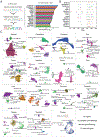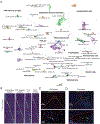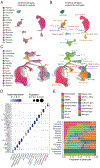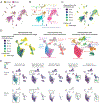A human cell atlas of fetal gene expression
- PMID: 33184181
- PMCID: PMC7780123
- DOI: 10.1126/science.aba7721
A human cell atlas of fetal gene expression
Abstract
The gene expression program underlying the specification of human cell types is of fundamental interest. We generated human cell atlases of gene expression and chromatin accessibility in fetal tissues. For gene expression, we applied three-level combinatorial indexing to >110 samples representing 15 organs, ultimately profiling ~4 million single cells. We leveraged the literature and other atlases to identify and annotate hundreds of cell types and subtypes, both within and across tissues. Our analyses focused on organ-specific specializations of broadly distributed cell types (such as blood, endothelial, and epithelial), sites of fetal erythropoiesis (which notably included the adrenal gland), and integration with mouse developmental atlases (such as conserved specification of blood cells). These data represent a rich resource for the exploration of in vivo human gene expression in diverse tissues and cell types.
Copyright © 2020 The Authors, some rights reserved; exclusive licensee American Association for the Advancement of Science. No claim to original U.S. Government Works.
Conflict of interest statement
Figures






Comment in
-
A molecular handbook for human development.Nature. 2021 Feb;590(7844):43-44. doi: 10.1038/d41586-021-00142-8. Nature. 2021. PMID: 33500582 No abstract available.
Similar articles
-
A human cell atlas of fetal chromatin accessibility.Science. 2020 Nov 13;370(6518):eaba7612. doi: 10.1126/science.aba7612. Science. 2020. PMID: 33184180 Free PMC article.
-
A single-cell atlas of chromatin accessibility in the human genome.Cell. 2021 Nov 24;184(24):5985-6001.e19. doi: 10.1016/j.cell.2021.10.024. Epub 2021 Nov 12. Cell. 2021. PMID: 34774128 Free PMC article.
-
Single cell dual-omic atlas of the human developing retina.Nat Commun. 2024 Aug 9;15(1):6792. doi: 10.1038/s41467-024-50853-5. Nat Commun. 2024. PMID: 39117640 Free PMC article.
-
Considerations for building and using integrated single-cell atlases.Nat Methods. 2025 Jan;22(1):41-57. doi: 10.1038/s41592-024-02532-y. Epub 2024 Dec 13. Nat Methods. 2025. PMID: 39672979 Review.
-
More than a decade of developmental gene expression atlases: where are we now?Nucleic Acids Res. 2009 Dec;37(22):7349-59. doi: 10.1093/nar/gkp819. Nucleic Acids Res. 2009. PMID: 19822576 Free PMC article. Review.
Cited by
-
TEDD: a database of temporal gene expression patterns during multiple developmental periods in human and model organisms.Nucleic Acids Res. 2023 Jan 6;51(D1):D1168-D1178. doi: 10.1093/nar/gkac978. Nucleic Acids Res. 2023. PMID: 36350663 Free PMC article.
-
Missense variants in DPYSL5 cause a neurodevelopmental disorder with corpus callosum agenesis and cerebellar abnormalities.Am J Hum Genet. 2021 May 6;108(5):951-961. doi: 10.1016/j.ajhg.2021.04.004. Epub 2021 Apr 23. Am J Hum Genet. 2021. PMID: 33894126 Free PMC article.
-
Experimental development of the epigenomic library construction method to elucidate the epigenetic diversity and causal relationship between epigenome and transcriptome at a single-cell level.Genomics Inform. 2022 Mar;20(1):e2. doi: 10.5808/gi.21078. Epub 2022 Mar 31. Genomics Inform. 2022. PMID: 35399001 Free PMC article.
-
Advances in mixed cell deconvolution enable quantification of cell types in spatial transcriptomic data.Nat Commun. 2022 Jan 19;13(1):385. doi: 10.1038/s41467-022-28020-5. Nat Commun. 2022. PMID: 35046414 Free PMC article.
-
Effects of Isorhamnetin on Diabetes and Its Associated Complications: A Review of In Vitro and In Vivo Studies and a Post Hoc Transcriptome Analysis of Involved Molecular Pathways.Int J Mol Sci. 2022 Jan 9;23(2):704. doi: 10.3390/ijms23020704. Int J Mol Sci. 2022. PMID: 35054888 Free PMC article. Review.
References
-
- de Bakker BS, de Jong KH, Hagoort J, de Bree K, Besselink CT, de Kanter FEC, Veldhuis T, Bais B, Schildmeijer R, Ruijter JM, Oostra R-J, Christoffels VM, Moorman AFM, An interactive three-dimensional digital atlas and quantitative database of human development. Science. 354 (2016), doi:10.1126/science.aag0053. - DOI - PubMed
-
- Jirasek JE, An Atlas of the Human Embryo and Fetus: A Photographic Review of Human Prenatal Development (CRC Press, 2000).
Publication types
MeSH terms
Substances
Grants and funding
LinkOut - more resources
Full Text Sources
Other Literature Sources
Molecular Biology Databases

